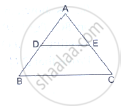Advertisements
Advertisements
प्रश्न
∆ABC is such that AB = 3 cm, BC = 2 cm and CA = 2.5 cm. If ∆DEF ∼ ∆ABC and EF = 4 cm, then perimeter of ∆DEF is
विकल्प
7.5 cm
15 cm
22.5 cm
30 cm
उत्तर
Given: In ΔABC, AB = 3cm, BC = 2cm, CA = 2.5cm. `ΔDEF ∼ Δ ABC ` and EF = 4cm.
To find: Perimeter of ΔDEF.
We know that if two triangles are similar, then their sides are proportional
Since ΔABC and ΔDEF are similar,
`(AB)/(DE)=(BC)/(EF)=(CA)/(FD)`
`3/(DE)=2/4=2.5/(FD)`
`3/(DE)=2/4`...............(1)
`DE=6cm`
`2/4=2.5/(FD)`
`FD=5cm......................(2)
From (1) and (2), we get
Perimeter of ΔDEF = DE + EF + FD = 6 + 4 +5 = 15 cm
Hence the correct answer is `b`
APPEARS IN
संबंधित प्रश्न
D and E are points on the sides AB and AC respectively of a ΔABC. In each of the following cases, determine whether DE║BC or not.
AB = 10.8cm, AD = 6.3cm, AC = 9.6cm and EC = 4cm.

Corresponding sides of two similar triangles are in the ratio 1 : 3. If the area of the smaller triangle in 40 cm2, find the area of the larger triangle.
The diagonals of quadrilateral ABCD intersect at O. Prove that
`[A(∆"ACB")]/[A(∆"ACD")] = "BO"/"DO"`
In ∆ABC, ray AD bisects ∠A and intersects BC in D. If BC = a, AC = b and AC = c, prove that \[DC = \frac{ab}{b + c}\]
State SSS similarity criterion.
If the areas of two similar triangles ABC and PQR are in the ratio 9 : 16 and BC = 4.5 cm, what is the length of QR?
If ∆ABC and ∆DEF are two triangles such tha\[\frac{AB}{DE} = \frac{BC}{EF} = \frac{CA}{FD} = \frac{2}{5}\] , then Area (∆ABC) : Area (∆DEF) =
If in two triangles ABC and DEF, \[\frac{AB}{DE} = \frac{BC}{FE} = \frac{CA}{FD}\], then
∆ABC ∼ ∆PQR such that ar(∆ABC) = 4 ar(∆PQR). If BC = 12 cm, then QR =
If ABC is an isosceles triangle and D is a point of BC such that AD ⊥ BC, then
